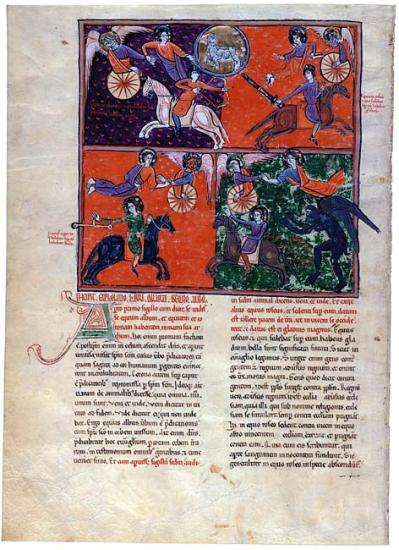
Opening Of The First Four Seals: The Four Horsemen
Beatus of Liébana
Las Huelgas Apocalypse
Purchased by Pierpont Morgan, 1910
And I saw that the Lamb had opened one of the seven seals. And I heard one of the four living creatures saying, "Draw near and see." And I saw a white horse, and the rider was holding a bow, and a crown was given to him, and he went forth conquering. And when he opened the second seal, the second living creature spoke. And a red horse went forth, and it was granted to its rider that he would take peace from the earth, and that they would kill one another. And a great sword was given to him. And when he opened the third seal, the third living creature spoke. And he saw a black horse, and its rider was holding a balance in his hand. And when he opened the fourth seal, the fourth living creature spoke. And I saw a pale horse, and the rider's name was Death, and Hell was following him. And authority was given to him over the four parts of the earth, to destroy by the sword, by famine, and by death. (Rev. 6:1–8)
As the lamb opens each of the seals, one of the living creatures takes John by the hand and lifts him into the air. Curiously, the first two horsemen seem to fight one another; they wear helmets with nose protectors. The other two horsemen have halos. Hell is shown as a hairy blue figure, deriving from the belief that demons were made of air.
The Apocalypse, or Book of Revelation, is not only the last Book of the New Testament, but its most difficult, puzzling, and terrifying. It provided challenges to medieval illustrators and was the source for a number of popular images, such as Christ in Majesty, the Adoration of the Lamb, and the Madonna of the Apocalypse and contributed to the widespread use of the Evangelists' symbols.
Selected images from Apocalypse Then: Medieval Illuminations from the Morgan, an exhibition held at the Morgan are presented here. The exhibition celebrates the completion of a facsimile of the Morgan's Las Huelgas Apocalypse—the latest dated (1220) and largest surviving manuscript of a Spanish tradition of illuminated commentaries on the Apocalypse by the monk Beatus of Liébana. The series of manuscripts constitutes Spain's most important contribution to medieval manuscript illumination.
The Las Huelgas Apocalypse contains three sections: the prefatory cycle, the Apocalypse, and the Book of Daniel.
In addition to forty-nine images from the Las Huelgas Apocalypse, six images from other manuscripts in the Morgan's collections, including the earliest Beatus painted by Maius and one by the Master of the Berry Apocalypse, are in this presentation.
